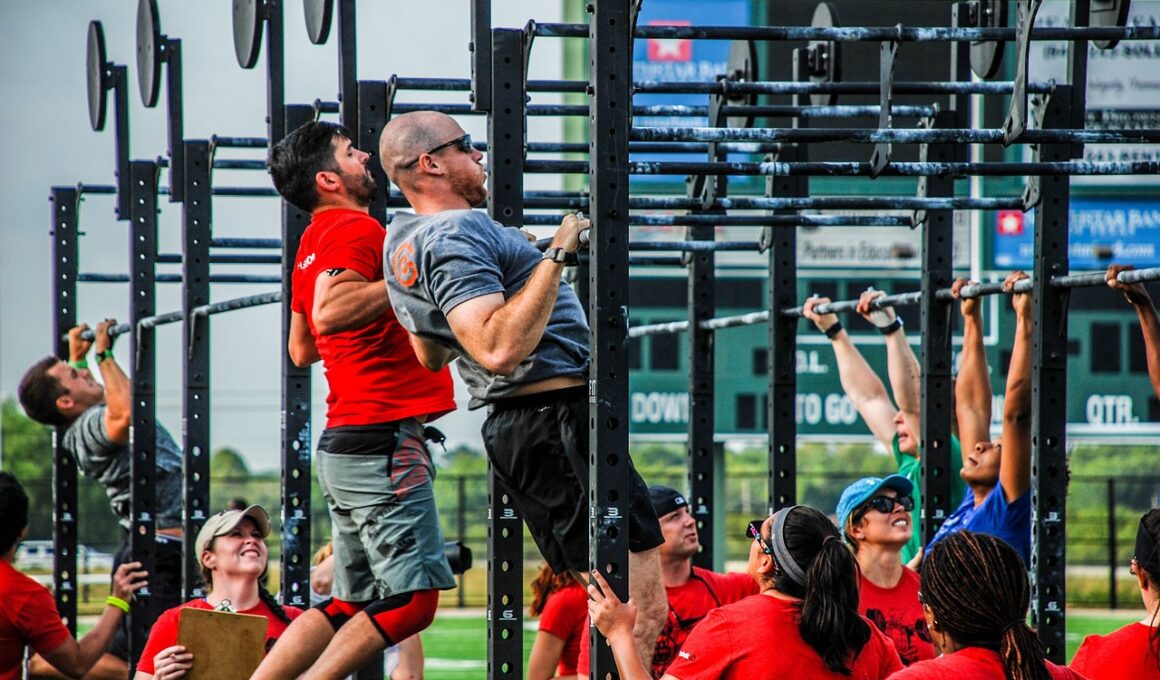How to Structure Your Weekly CrossFit Workouts
Structuring your weekly CrossFit workouts effectively is crucial for achieving optimal performance and results. A well-balanced program should incorporate a variety of elements such as strength training, cardio, mobility, and skill work. Each of these components plays a vital role in enhancing your overall fitness and ensuring you’ll be prepared for any WOD challenge ahead. Begin by assessing your fitness goals and identify what skills you want to develop most. Plan to include diverse movement patterns aiming for functional strength and endurance. Using a mix of lifting days, conditioning workouts, and skill sessions will ensure a well-rounded approach. You can organize your training by separating strength and conditioning phases or integrating them together. Additionally, allocating specific days for recovery is crucial for prep and adaptation. Other aspects to consider are balancing workout intensity and ensuring adequate rest periods. These vital components will help prevent overtraining while promoting improvements in your physical capacities. Be flexible and adjust your routine based on how your body responds to the increasing demands and adapt your weekly structure accordingly.
Another crucial strategy involves planning your weekly workout routine with specific goals for each session. Design different workout focuses for each day, making sure to alternate strength-building sessions with high-intensity conditioning days. This allows for maximum effort on demanding days while limiting fatigue over time. When creating your weekly programming, consider incorporating Olympic lifts, powerlifting, or gymnastics work to develop new skills and strength. Look for specific movements that require more attention and schedule those for when you have the most energy. Remember to include benchmark workouts to track progress. This can help maintain motivation and give you a yardstick for measuring improvements. Utilizing rest days wisely is just as important, so remember to listen to your body. Include active recovery sessions, focusing on mobility or flexibility rather than total rest. Also, be sure to encourage supplementary activities outside the gym, such as running, swimming, or cycling, to help build endurance. Making sure to implement a variety of training styles will keep things fresh while supporting overall development. This balanced approach can open new opportunities for growth and discovery in your CrossFit journey.
Balancing Strength and Cardio
A key aspect of constructing your weekly CrossFit program is balancing strength and cardio. It’s vital to focus on both elements because they complement each other, creating well-rounded fitness levels. For strength days, incorporate compound lifts and accessory movements targeting multiple muscle groups, such as squats, deadlifts, or bench presses. These exercises promote muscle growth and strength, which in turn supports your performance during workouts. On cardio days, prioritize metabolic conditioning workouts that elevate your heart rate while building endurance. Consider styles like AMRAPs or EMOMs for heightened engagements in your conditioning efforts. Adjust the intensity and time for each component based on overall goals. Be sure to alternate your workouts, allocating specific days for strength and conditioning. This can decrease burnout and promote recovery period, so you may benefit from alternating difficult workout days with lighter ones focused on skill development or flexibility. Doing so ensures you maintain mental and physical energy, and prevents monotony in your training. Ultimately, a properly planned mix of strength and oxygen intake sessions can enhance performance in CrossFit competitions and daily activities.
Incorporating variety is vital to producing effective weekly programming in CrossFit. Regularly explore new techniques, movement patterns, and workout formats to keep things engaging. You may also challenge yourself with different equipment, such as kettlebells, medicine balls, or resistance bands. This diversity will help you develop a comprehensive skill set while preventing training plateaus. Consider including interval sprint work as a way to keep cardio workouts fresh. Try alternating between short bursts of high-intensity exercises and more prolonged moderate effort exercises. This will stimulate different energy systems and boost your overall capacity. Additionally, don’t hesitate to experiment with various workout formats, such as partner workouts, team WODs, or solo challenges. Such practices motivate collaboration and competitiveness within the gym, encouraging camaraderie among fellow athletes. While continuously adjusting your programming, remember to emphasize recovery time as well, especially after challenging workouts. Implementing deload weeks and lighter sessions throughout your programming helps to refresh your body while preparing for subsequent challenging periods. Effectively balancing these aspects will lead to consistent advancements in performance and enjoyment of your CrossFit journey.
Monitoring Recovery and Progress
A critical component of any successful workout regimen is monitoring recovery strategies. Pay attention to how your body feels after rigorous training sessions; listen for signs of fatigue or overtraining. Incorporate recovery tactics such as adequate sleep, hydration, nutrition, and stretching. Effective recovery allows your muscles to repair and grow stronger, ultimately leading to better performance in future WODs. Don’t forget the importance of nutrition for recovery and performance. Eating appropriate macronutrients helps fuel your workouts and prepare your body for the following challenging sessions. Prioritize post-workout meals containing carbohydrates and proteins to replenish energy sources and facilitate muscle repair. Additionally, taking time to evaluate your weekly programming can help you identify which workouts yield the best results. Keeping a workout journal can be an effective method for tracking your progress. Note key performance metrics, such as weights lifted, repetitions performed, and time taken to complete workouts. By maintaining this log, you can easily spot trends and areas demanding improvement. This knowledge allows you to tailor your programming even further, ensuring you remain engaged in training while continuously advancing towards your goals.
CrossFit workouts can often become monotonous without creativity and inspiration during your training process. As a result, maintaining a fresh approach to your weekly workout structure is essential for long-term enjoyment. Consider involving friends or signing up for classes outside of your usual gym environment to spark new motivation. Participating in workshops and seminars can enhance your skills and introduce you to innovative training techniques, while cultivating the community spirit inherent in CrossFit culture. Additionally, regularly revisiting and engaging with your goals will help keep your focus sharp. Create SMART (Specific, Measurable, Achievable, Relevant, and Time-bound) goals tailored to your fitness aspirations. These provide a framework to stay on track while producing a sense of accomplishment over time. Incorporate seasonal challenges such as themed workouts to add enjoyment and reality checks to improve fitness. Explore local competitions as a means to push your limits while learning from others’ experiences. Embrace the idea that change is inevitable and essential to maintaining enthusiasm for your workouts. Implement new trends as they arise, and don’t hesitate to adapt your programming to reflect these changes in the continuously evolving world of CrossFit.
Conclusion and Tips
In conclusion, structuring your weekly CrossFit workouts can lead to enhanced performance and results when approached strategically. Balance strength, cardio, and recovery with a diverse range of workout types to keep your training both exciting and effective. Remember to assess your current fitness level and personalize your goals for optimum improvement. Exploring different training styles, focusing on active recovery, and challenging yourself are all essential ingredients to achieving your desired outcomes. Consider engaging with the supportive CrossFit community as a way to stay motivated and inspired through various workouts, classes, and competitions available. Finding balance in your weekly programming, alternating workout intensities, and investing in recovery will sustain your development and enthusiasm. Adapt and embrace various components of your overall fitness journey while keeping the spirit of CrossFit alive. The beauty of CrossFit lies in its ability to bring forth every individual’s strengths and weaknesses while providing the necessary tools to overcome them. So go ahead, implement the tips discussed, and watch as you grow, evolve, and thrive within CrossFit.
Train hard, understand your recovery needs, and appreciate the varied journeys each individual takes in the world of fitness. With these components combined into your weekly CrossFit programming, it’s likely you’ll cultivate both confidence and capability in all aspects of your fitness. Set aside the time each week to engage in purposeful training that excites you, while challenging your limits. Make your journey fun, enjoyable, and rewarding — just like CrossFit strives to promote among athletes worldwide. The success found through dedication to programming will empower you, translating potential into concrete results. Take your time and enjoy every workout, whether it’s a personal best or a collaborative team effort. Above all, connect with the community, friendships, and valuable lessons you acquire along the way. Progress is both a personal journey and a shared experience, so be patient with your body and your goals. Embrace the resilience fostered through hard work, and let that motivate you to rise higher and keep pushing your limits. The continuous cycle of improvement will nourish your passion for CrossFit and promote lasting fulfillment.


